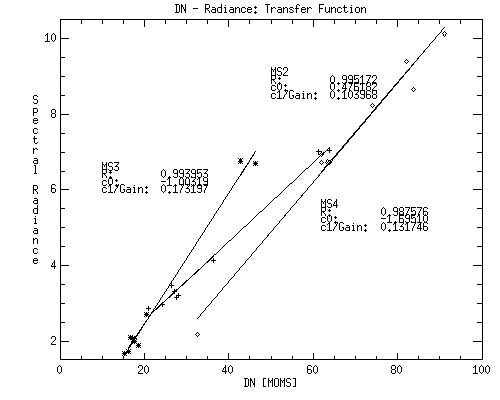MOMS-02/D2: Validation and Calibration
The validation and calibration of MOMS-02 data is based on imagery taken during the STS-55/D2 mission.
In-flight calibration has been performed by an intersensor calibration method (TM-MOMS). Transfer functions to convert grey values to spectral radiance are given in the diagram above. These are necessary e.g. for atmospheric corrections as preprocessing for multi-temporal image analysis.
In order to derive a measure of the instruments in-flight performance, several algorithms and approaches have been used. The following performance parameters have been investigated:
- Visual Inspection (band to band registration, noise, blur)
- Fourier Analysis
- Entropie
- Signal to Noise Ratios (SNR)
- Line Spread Function (LSF)
- Spectral Significance (de-correlation, saturation)
The spatial and spectral information content confirms the new band design. Investigations on the spectral significance of the multispectral bands clearly indicate an improvement of spectral information content due to the narrow band design, while broadening the panchromatic bands into the near infrared spectral region gives a better differentiation of low albedo targets. Thus, the panchromatic bands are well suited to extract texture descriptors, point matching using autocorrelation techniques and for merging concepts with lower resolving multispectral bands. Furthermore, results of the LSF investigations are rather satisfying as compared to the LSF performance of the predecessor MOMS-01. Residual image distortions occurred at Shuttle mission STS-55 due to malfunctioning electronic modules and due to a missing thermal environment. This problems were taken into account during the construction of the MOMS-2P sensor in the course of PRIRODA mission.


